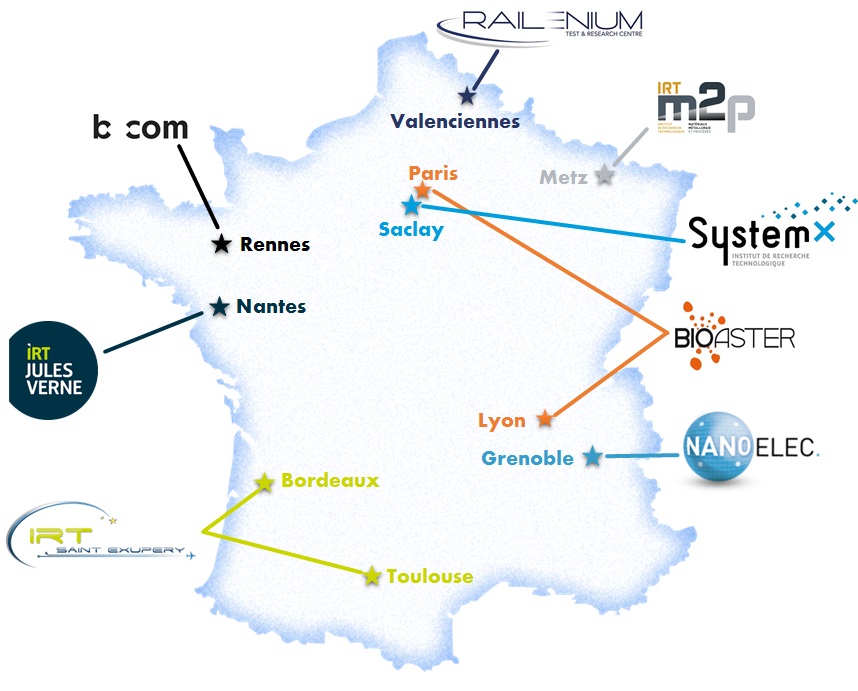Research and Technology Organisations in France
In addition to its world-renowned public research laboratories, France also counts several types of Research and Technology Organisations (RTOs) such as the Carnots Institutes, the IRTs and the ITEs, which aim at boosting national economic growth and competitiveness.
1. Carnot Institutes (iC)

The Carnot Institutes have been designed in 2006 to facilitate the acceleration of technology transfer and innovation through long-term collaborative R&D between businesses and existing public research laboratories.
Following an open selection process, laureate public research institutions are awarded not only the label “Institut Carnot” for a 5-year renewable period, they are also eligible for additional public funding that match – Euro for Euro – private funding they raise through research contracts.
Facts and Figures
• 34 Institutes across France, covering all areas of science;
• €455m in research contracts with industry (including €109m – 24% with SMEs and intermediate-sized companies);
• €200m from international activities (R&D for international companies, European collaborative projects and non-European collaborative projects);
• €2,200m annual consolidated budget;
• €47m in annual intellectual property revenues;
• 65 spin-off companies per year;
• 1,000 priority patents filed in 2013.
Strength of the Carnot Network
The four main factors driving efficiency of the Carnot Institutes are:
• long-term binding objectives with partner companies;
• fine adjustments to objectives made annually according to changing ecosystem conditions;
• an integrated network;
• a performance-based funding mechanism.
2. Instituts de Recherche Technologique (IRT)
The “Instituts de Recherche Technologique” (IRT) have been created in 2012, within the “Investments for the Future” programme, with the purpose of boosting the competitiveness of strategic technological sectors and promoting local economic growth around the best performing “competitiveness clusters”.

What is an IRT?
An IRT:
• is a physical research centre focused on a specialised scientific or technological topic;
• concentrates at a single site highly skilled technical personnel, state-of-the-art equipment, and facilities at the forefront of technology;
• focuses on the development of activities at the TRLs range from 3 to 6, including:
o applied/technological research
o production of demonstrators/industrial prototypes
Facts and Figures
• 8 IRTs across France:
o b<>com (Digital Technologies; Rennes),
o Bioaster (Infectiology and microbiology; Lyon and Paris)
o Jules Verne (Advanced manufacturing; Nantes)
o M2P (Materials, metallurgy and processes; Metz)
o Nanoelec (Nanoelectronics; Grenoble)
o Railenium (Railway systems; Valenciennes)
o Saint Exupéry (Aeronautics, space and Embedded Systems; Toulouse-Bordeaux)
o SystemX (Digital engineering of complex systems, Paris-Saclay)
• 50-50 public-private partnership between the French government, higher education and public research organisations and key industrial partners;
• initial public investment of €2bn;
• nearly 400 members:
o 75% market-leading businesses of all sizes;
o 25% top-tier academic research organisations.
French Institutes of Technology Association
In order to step up, gain visibility and become key partners for both businesses and public technological research organisations internationally, the IRTs launched the “French Institutes of Technology “(FIT) Association. FIT’s other missions are to facilitate the development of best practices and to act as a single voice in interactions with the European Commission and French funders.
3. Instituts pour la Transition Energétique (ITE)
The “Instituts pour la Transition Energétique” (ITE) were also launched within the “Investments for the Future” programme. Like the IRTs (lien), they are thematic institutes based on a public-private partnership aiming at the promotion of French competitiveness, innovation and growth. However, they show three distinctive features:
• a focus on low carbon technologies;
• a wider breadth of technology readiness levels, including fundamental research;
• a nationwide reach, including partners spread across France, rather than in a single region.
Facts and Figures
• 8 existing ITEs:

o France Energies Marines (€34.3m, marine energy)
o Geodenergies (€15.9m, geothermal energy, energy storage and CO2 storage)
o Ideel (€39.7m, factories of the future)
o Institut français des matériaux agro-sourcés (€30.8m, agro-sourced materials)
o Institut Photovoltaïque d’Île de France (€18.1m, photovoltaic energy)
o PIVERT (€63.8m, oilseed biomass)
o Supergrid (€72.6m, future electric transmission network)
o VéDéCom (€54.1m, low carbon vehicles)
• Initial public investment of €1bn
• 4 additional ITE projects are currently being considered